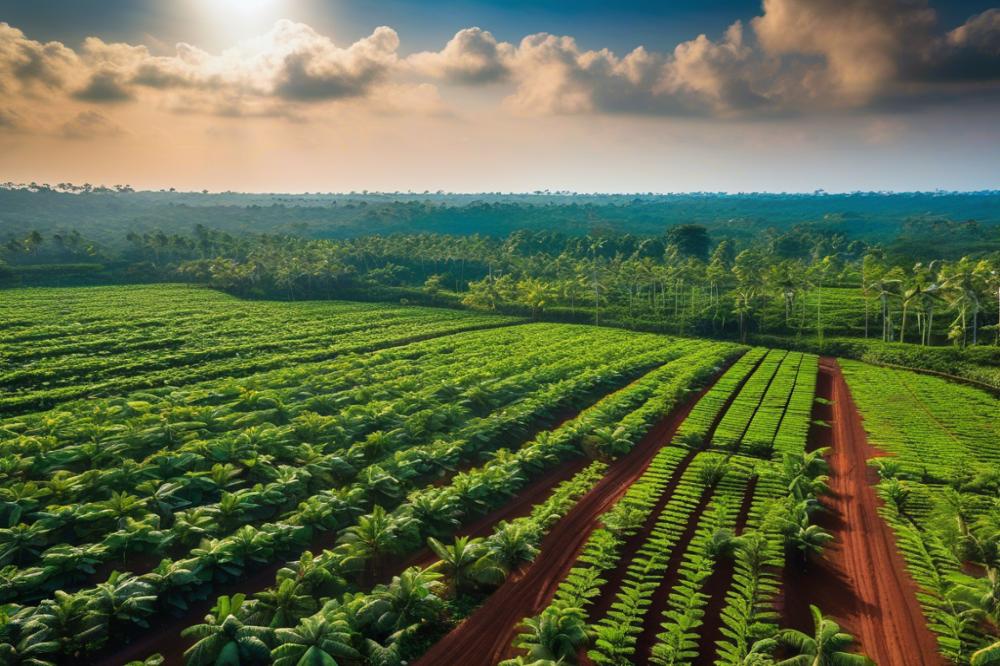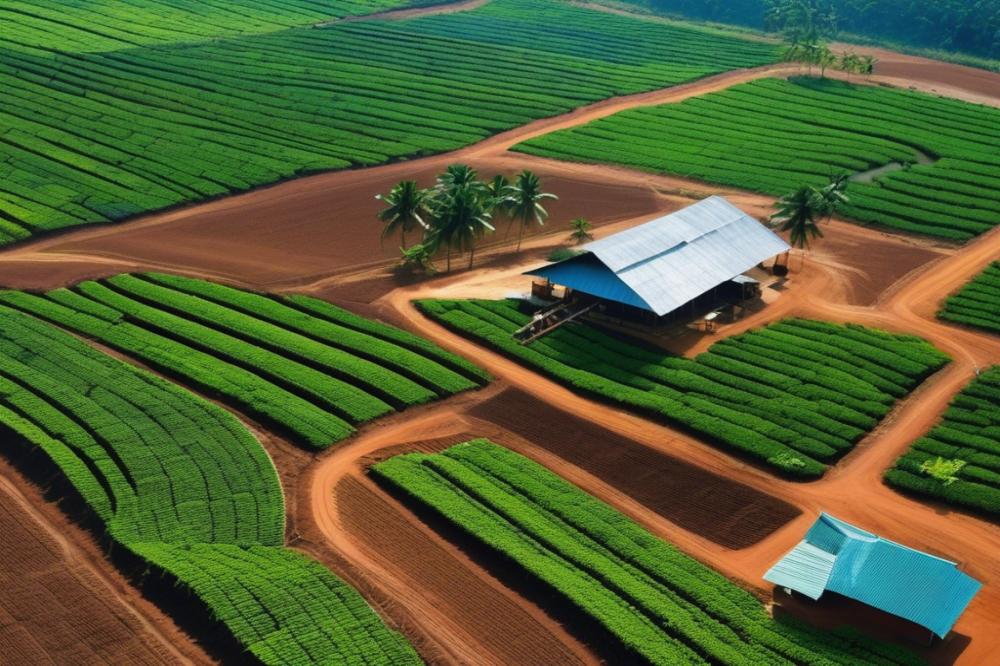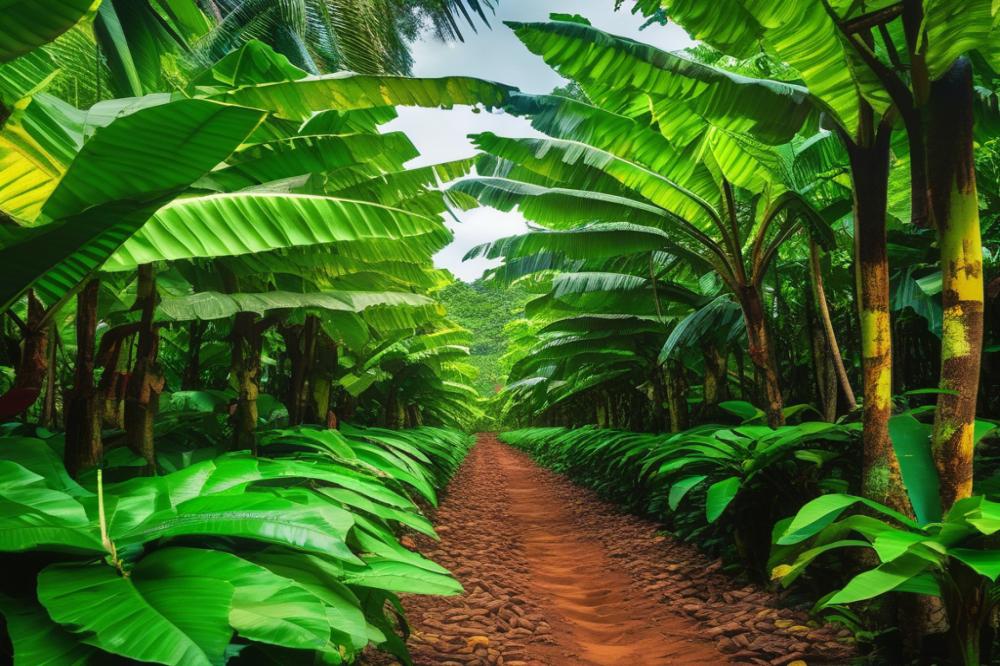chocolatebix.com/health-benefits-of-cocoa-why-it-s-good-for-you”>cocoa and chocolatebix.com/cocoa-vs-chocolate-understanding-the-difference”>climate change: Challenges and Innovations
The cocoa industry plays a crucial role in the global economy. Millions of people depend on it for their livelihoods. Beyond economic contributions, the crop also supports cultural traditions across many regions. However, it faces a daunting challenge with climate change. Rising temperatures and unpredictable weather patterns threaten production levels. This not only impacts farmers but also the communities that rely on them.
Climate change has repercussions far beyond the farm. It disrupts agriculture and affects the viability of this unique crop. Farmers struggle to maintain their yields as soil quality deteriorates and pests thrive in warmer conditions. As a result, crop resilience is at stake. The future of the cocoa industry hangs in the balance, and urgent action is necessary to adapt.
Addressing these challenges is essential for sustainability. Promoting biodiversity may hold the key to creating more resilient farming systems. Techniques such as agroforestry can help mitigate the environmental impact of agriculture while enhancing productivity. These innovations not only lessen the carbon footprint but also support the ecosystem that cocoa depends on. Focusing on sustainable practices can reduce deforestation rates and protect vital habitats.
Investing in solutions now will lead to a more stable future. Emphasizing climate adaptation in farming methods can make a significant difference in crop production. The time to act is now. Farmers, researchers, and communities must collaborate to safeguard the future of cocoa and ensure sustainable practices thrive. By fostering innovation and adapting to changing climates, it is possible to protect both the industry and the planet.
The Impact of Climate Change on Cocoa

Rising temperatures are having a serious effect on cocoa yield. As the planet warms, optimal conditions for growth are shifting. Farmers may find it harder to maintain healthy crops. Each degree Celsius increase can lower yields by 10% or more. The situation is alarming for those who rely on this cash crop for their livelihoods. Farmers who have grown it for generations are beginning to feel the pressure.
Changing Rainfall Patterns and Their Consequences
Rainfall patterns are becoming less predictable. Some regions may experience heavier rains, while others may face drought. These inconsistent weather patterns impact soil moisture and directly threaten crop resilience. Farmers need steady conditions to thrive. Less rainfall during critical growth periods can stunt development and yield.
In addition, heavy rains often lead to increased flooding, which can wash away crops and harm soil quality. Deforestation exacerbates this problem. Without trees to stabilize the soil, erosion can become severe. This loss of land not only challenges farmers but also threatens biodiversity in the area. Diverse ecosystems are crucial for maintaining environmental balance.
Influence of Climate Change on Cocoa Pest and Disease Prevalence
Pest and disease prevalence is closely tied to climate conditions. Warmer temperatures create favorable environments for pests. As insect populations grow, they can decimate entire crops. Moreover, diseases can spread more quickly in warmer climates, leading to even greater loss. Farmers must adapt their strategies to combat these threats.
Innovative farming techniques can help mitigate some risks. Agroforestry is one such method that increases biodiversity while providing shade for crops. Planting trees alongside cocoa can enhance soil health and reduce carbon footprint. This practice promotes sustainability, making the land more resilient. Adapting to climate challenges is essential for survival in this industry.
Challenges Facing Cocoa Agriculture

Deforestation is a major threat to cocoa production. Trees are often cut down to clear land for farming. This leads to loss of habitat for many species. The removal of trees reduces the area’s ability to absorb carbon dioxide. As a result, the carbon footprint of agriculture increases. Many farmers face pressure to expand their fields. They may choose short-term profit over long-term environmental health.
Biodiversity Loss and Its Effects on Cocoa Ecosystems
Biodiversity is crucial for healthy ecosystems. Diverse environments support a wide range of species. When these environments are damaged, agriculture can suffer. Pests and diseases can become more prevalent when natural balances are disrupted. Erosion of plant and animal diversity can lead to challenges for farming techniques. Crop resilience might diminish, leaving farmers vulnerable to climate impacts.
Economic Pressures on Farmers
Farmers face many economic challenges in cocoa agriculture. Prices for cocoa have fluctuated widely. This instability makes it hard for farmers to plan for the future. Some are pushed to adopt unsustainable practices, just to survive. The demand for sustainable agriculture is growing, yet many farmers lack access to resources. They need support to implement innovative methods like agroforestry and alternative crop systems. Climate adaptation can also be costly. Investment in improved practices can help farmers thrive while protecting the environment.
Innovative Farming Techniques for Cocoa

Agroforestry Systems and Their Benefits
Agroforestry combines agriculture with forestry. This method supports sustainability by planting trees alongside crops. Trees provide shade and protect plants from harsh weather. Moreover, their roots prevent soil erosion. Farmers benefit from having more diverse ecosystems. These systems promote biodiversity, which is crucial for pest control. By integrating trees, farmers can create habitats for various species. This approach also promotes carbon sequestration, reducing the carbon footprint of agriculture. Agroforestry contributes not just to farming but to the health of the planet.
Crop Resilience Through Diversified Farming
Diversifying crops helps farmers adapt to changing climates. Planting a variety of species makes fields less vulnerable to pests and diseases. Crop resilience increases when farmers mix different plants. This practice minimizes risks and can lead to higher yields. Natural variations in weather will have less impact on diverse farms. By growing multiple crops, farmers can ensure steady harvests year after year. Also, this method supports local economies. More options mean more income opportunities for farmers.
Sustainable Practices to Reduce Carbon Footprint
Adopting sustainable practices is essential for the future of farming. Techniques like cover cropping and reduced tillage are effective. These methods enrich the soil without disturbing it much. Less soil disturbance leads to greater carbon retention. Implementing organic fertilizers reduces reliance on harmful chemicals. This promotes both health and environmental sustainability. Innovative approaches, such as using compost, further enhance soil quality. Such practices contribute to climate adaptation as they mitigate the effects of climate change. Farmers can actively play a role in fighting deforestation with these effective techniques.
Climate Adaptation Strategies in Cocoa Farming
Challenges caused by climate change are serious for farmers. They face threats like shifting rainfall patterns and rising temperatures. Climate-smart agriculture methods can provide solutions. These strategies help improve the overall health of the land while supporting crop resilience.
Importance of Climate-Smart Agriculture
Using climate-smart practices is key in today’s world. Such strategies include crop rotation and improved soil management. These techniques not only protect the environment but also enhance biodiversity. When farmers adopt these methods, they can reduce their carbon footprint. Healthier ecosystems contribute to more stable yields, which benefits the whole community.
Development of Climate-Resilient Cocoa Varieties
Scientists work hard to develop unique cocoa varieties. These new plants can withstand extreme weather conditions like drought and flooding. They aim for crops that require less water and are resistant to diseases. Innovations in breeding can save farmers from low yields during tough times. Offering robust options helps secure future harvests and promotes sustainability in agriculture.
Support for Farmers in Adapting to Climate Change
Help is essential for farmers facing adversity. Training and resources allow them to adopt new farming techniques. Government programs and NGOs frequently step in to offer crucial support. Access to financial assistance is vital for making transitions. Communities can come together to share knowledge about agroforestry, which combines crops with trees. This not only helps create strong farming systems but also protects against deforestation.
The Role of Technology and Innovation
Digital tools are transforming the way farmers approach agriculture. Mobile apps can provide real-time weather updates and market prices. This information helps farmers make better decisions about when to plant and harvest. Crop monitoring systems using drones can also offer valuable insights into plant health and growth patterns.
Research and development are crucial for promoting sustainability in cocoa farming. Scientists are exploring new farming techniques that support biodiversity and enhance crop resilience. These innovations can help reduce the reliance on chemicals, which often hurt the environment. Improved practices can also mitigate deforestation by making existing farms more productive.
Innovative approaches to improve yield are vital for adapting to climate change. Agroforestry, for example, involves planting trees alongside crops. This method can lower carbon footprints while providing additional revenue streams for farmers. Education programs can teach farmers about advanced practices that lead to better soil health and higher yields.
Farmers now have access to genetic research that develops more resilient varieties of cocoa. These new crops can withstand extreme weather conditions and pests, ensuring a steadier supply. With collaboration between local communities and research institutions, innovation becomes a shared goal. Such partnerships foster a strong commitment to sustainable practices.
Technology’s potential in this field cannot be overstated. Sensors in the field monitor soil moisture and nutrient levels, leading to data-driven decisions. Farmers who embrace these smart technologies can increase their productivity while minimizing environmental impact.
Partnerships and Collaboration for Sustainability
Governments, NGOs, and the private sector play critical roles in supporting sustainable practices. These groups must work together to tackle the challenges posed by climate change. Programs that promote sustainable agriculture practices can improve crop resilience and reduce deforestation. Collective efforts often lead to strong policies that push for environmental standards.
Certification programs are important for ensuring responsible practices. They help consumers make informed choices about products they purchase. These labels not only promote sustainability but also encourage better farming techniques. They create a marketplace that rewards farmers who prioritize environmental stewardship. By choosing certified products, buyers reduce their carbon footprint too.
Community involvement is essential for effective climate action. Local farmers know their land best. When involved in decision-making, they can contribute valuable insights. Agroforestry is one approach that can benefit both communities and the environment. Planting trees alongside crops enriches biodiversity while enhancing soil quality. It also creates more resilient systems that withstand extreme weather.
Innovation is vital in adapting to changing climates. New technologies can help farmers monitor their fields and optimize practices. Solutions such as precision agriculture can improve yields without harming the planet. When stakeholders unite in promoting innovation, they drive sustainable changes that endure. By fostering collaboration, communities can prototype more efficient ways to tackle the issues they face.
Final Thoughts on Challenges and Innovations
The challenges facing chocolate production due to climate change are daunting. Rising temperatures, unpredictable rainfall, and pests threaten farmers and the quality of their crops. Many smallholder farmers, who rely on this agriculture for their livelihoods, cannot cope with these changes alone.
On the other hand, innovative solutions are emerging. Strategies like agroforestry help build resilience against climate impacts. Additionally, the development of disease-resistant plant varieties shows promise for better yields. These advancements aim to make farming practices more sustainable.
A collective effort from everyone involved is crucial. Governments, businesses, and non-profits need to work together. Investing in research and supporting local farmers are effective ways to address these issues. Training programs can help equip farmers with the skills needed to adapt to new conditions.
Everyone has a role to play in promoting sustainability within the cocoa industry. Customers can make informed choices by supporting brands committed to ethical sourcing. Meanwhile, industry leaders should prioritize environmentally friendly practices. Every small action contributes to large-scale change.
As the world faces climate challenges, we must remember that cocoa is not just a chocolate ingredient. It’s a vital part of many communities and ecosystems. By working together, we can create a brighter future for cocoa producers and the planet.



